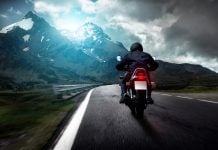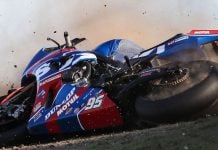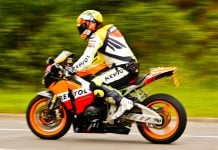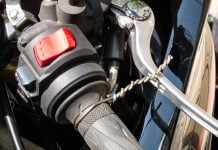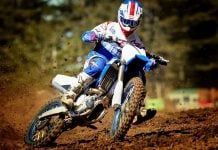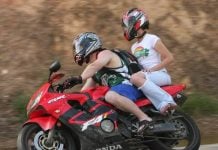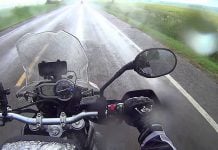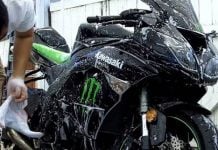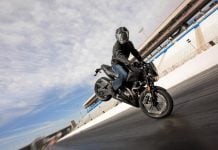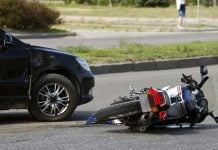ABS
The ABS (Antilock Braking System) was designed to prevent the brake from locking the wheel in strong braking or low grip surfaces. Through sensors that detect the movement of the wheels (amount other parameters), an electronic control unit commands a hydraulic pump that momentarily relieves pressure on the disc when there is a tendency of locking while the motorcycle is in motion. The ABS system doesn’t reduce the braking distance, it only helps to maintain traction.
Between-axes
It’s the distance between the axles of the front and rear wheels of the motorcycle. In practice, the smaller this distance the greater will be ability to perform curves and manoeuvres with agility. In long-wheelbase bikes the stability of the straight lines is prioritised in detriment to the performance in the bends.
Casing Angle
It’s the angle of inclination of the front suspension relative to the ground. A smaller crank angle, as in sport bikes, priorities agility in steering changes, while the larger crank angle, as in chopper bikes, favours stability on straight lines.
CC’s (Cubic Centimeters)
It indicates the volume of the combustion chamber of the engine, ie how much air / fuel mixture it’s able to receive.
Compression Ratio
Represents how much volume of air/fuel admitted into the combustion chamber is compressed until the piston rises fully (top dead centre). With the piston in the lower dead centre and the chamber volume with the piston in the upper dead decanter.
When an engine have a 12:1 compression ratio, the fully extended combustion chamber is 12 times larger than fully compressed. In theory, the increase in compression ratio contributes to the increase in power by raising the rate of combustion; however, there are limitations such as pre-ignition of the fuel. In high performance engines with high compression ratio, the use of high octane gasoline is recommended to avoid pre-detonation.
Valve Control
It’s a mechanical system driven by the crankshaft to control the opening and closing of the intake and exhaust valves of the engine (which allow the fuel to enter and exhaust gases resulting from combustion). The most common systems are the rod-mounted control and the control on the head which uses a chain for camshaft.
Countersteering
It’s a riding technique that increases the tilt speed or change of direction of the motorcycle over 40km/h. It consists of slightly pushing the handlebar on the side the motorcycle needs to be directed.
Dry Weight
It’s the weight of the motorcycle without any liquid needed for operation such as engine oil, fuel, coolant and brake fluid.
Power (hp)
It’s the speed of transformation of one energy into another. In the case of motorcycles, it’s the chemical energy contained in the fuel transformed into mechanical energy through combustion.
Throttle Control
Only present in motorcycles with electronic fuel injection, the power control by mode selection or pre-programmed maps acts on the power and ignition systems to change the behaviour of the engine. It basically limits power and makes the responses smoother to increase safety in situations such as low-traction floors.
Primary Relation
It’s the crankshaft movement reduction system, composed of gears of varying diameters, which correspond to the gears.
Secondary Relation
It’s the final transmission system for the wheel movement. It can be composed of the pinion-chain0crown assembly by a toothed belt with two pulleys in place of the pinion and the crown or by the cordon shaft.
Slippery Clutch
Prevents locking the rear wheel in sudden gear reductions. When the reduction is strong enough to raise the engine speed too much, the clutch dosage times the rider.
Suspension Settings
They can be of three types (preload, compression and return). The preload compresses the spring and must be adjusted according to the weight taken by the motorcycle. The compression and return adjustments control the speed at which the damper is compressed upon impact and the speed at which it returns to the starting position, and directly influence the stability of the motorcycle.
Torque
It’s the lever force of the engine. It’s the force applied to an object to rotate it. In case of motorcycles we use the unit newton per meter (Nm).
Traction Control
It’s an electronic system that manages the power of the engine to avoid the rear wheel slippage (loss of traction) in strong accelerations. The main function of the traction control is to avoid falls due to excessive acceleration, but also contributes to the best use of the engine performance.
Trail (measure)
It’s the distance between the continuation of the incline line of the front suspension and the line of the wheel axis, projected horizontally on the ground. The greater the suspension inclination, the greater the distance.
TWI
Or Tire Wear Index is as small bump situated within the grooves of the tire. When the worn tread equals the height of the TWI, it means that the tire has reached the maximum wear point before the water drainage capacity is compromised. Therefore, it must be replaced.
Weight in running order
It’s the weight of the motorcycle ready to ride, including the fluids, lubricants and fuel required for operation.
